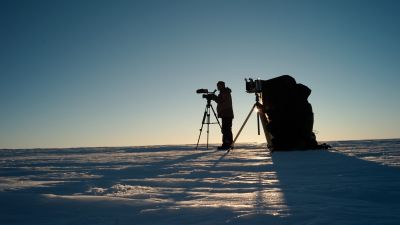
JARE 51 Meteorite Hunting Mission
The JARE 51 Mission to collect meteorites in the Eastern Sør Rondane Mountains was a success. The team, which spent the better part of four weeks in the field, found 635 meteorite fragments ranging in size from a few grams to 5 kg. Most of them were ordinary chondrites; however some are possible iron meteorites and others ureilites, although they will need to be taken back to a lab for further analysis. The team is very happy with the results!
-
The JARE-51/BELARE-SAMBA meteorite search program recovered a possible ureilite of 150-200 g (here next to a Gundam scale model of ~12 cm high)
© D. Sasaki / International Polar Foundation
-
Another view on the possible ureilite. Ureilites are the third rarest type of meteorite after aubrites and diogenites.
© D. Sasaki / International Polar Foundation
-
This fragment is an iron meteorite originating from the deep core of a former small planet.
© Y. Odaka / International Polar Foundation
-
Frontal view on the Shirase, the Japanese icebreaker that transported the team to Crown Bay, Antarctica.
© Steven Goderis / International Polar Foundation
-
Meteorites and the traps in which they are caught are generally widespread in the Antarctic. To get the highest recovery, snow mobiles are used to explore some 15 km² per day
© Steven Goderis / International Polar Foundation
-
Two pieces of a fragmented meteorite, exposed to the air long enough to be weathered and broken.
© Steven Goderis / International Polar Foundation
-
Frozen meteorite fragments need to be carefully removed in order not to contaminate them, they are then immediately sealed in plastic bags, kept frozen, shipped back to the laboratory, and brought to atmospheric temperature gradually
© Steven Goderis / International Polar Foundation
-
Search parties are also organized on foot in the vicinity of promising moraines. Everyone carries an ice pick to test the condition of the ice as crevasses (cracks in the blue ice) regularly occur.
© Steven Goderis / International Polar Foundation
-
Each sample is carefully documented (field number, coordinates, picture with scale) and handled to minimize the potential for contamination.
© Steven Goderis / International Polar Foundation
-
Example of a more extreme crevasse (filled with snow in between blue ice), about 5m wide.
© Steven Goderis / International Polar Foundation
-
On the way home after a day of exploring in an unknown area. The team members drive behind one another to avoid the risk of crevasses.
© Steven Goderis / International Polar Foundation
-
An ~5kg heavy ordinary chondrite (the most common type to reach the Earth), the largest meteorite fragment found during this expedition.
© Steven Goderis / International Polar Foundation
-
Not all meteorite fragments have been exposed to the air. Those completely encased in the blue ice are taken from the site with chisel and hammer.
© Steven Goderis / International Polar Foundation
-
A fairly complete meteorite fragment with a complete fusion crust.
© Steven Goderis / International Polar Foundation
-
Some colleagues driving through a local moraine in the Eastern Sør Rondane Mountains with ski-doos. Meteorites are also sometimes found in moraines.
© Steven Goderis / International Polar Foundation
-
Example of an ordinary chondrite found in a moraine. Only part of the original morphology has been preserved (flat side on the left), while the fusion crust has completely disappeared.
© Steven Goderis / International Polar Foundation
-
Geochemist Steven Goderis of the Vrije Universiteit Brussel next to a fresh find in the blue ice.
© Steven Goderis / International Polar Foundation
-
Walking over the blue ice and accompanied crevasses in search of meteorites.
© Steven Goderis / International Polar Foundation
-
Example of a moraine, accumulating thousands of rocks from large distances among which also meteorites.
© Steven Goderis / International Polar Foundation
-
Another example of a moraine.
© Steven Goderis / International Polar Foundation
-
A short lunch break in the field; Kaiden-san is trying to drink some hot tea and eat something small.
© Steven Goderis / International Polar Foundation
-
Meteorite fragment of approximately 0.5kg in the snow-covered blue ice.
© Steven Goderis / International Polar Foundation






















